
is Lord Kuber indian santa claus
If we compare the story of kuber from our ancient scriptures with the story of santa claus then you will find that all the stories and descriptions related to santa claus can be associated with stories of indian Deity kuber. In addition to comparison of santa claus with kubera, I will also be sharing some more additional details of deity Kuber which is missing in the description of santa claus..
Kuber is deity of wealth
In India, Goddess lakshmi is usually regarded as the goddess of wealth. But in reality, goddess lakshmi is the goddess of fortune which indirectly means Wealth and Deity kuber is regarded as the god of wealth. He is considered as the king of semi divine species called as yakshas. Regarded as the regent of the north, he is considered as the owner of all the treasures of the world. Kuber is often depicted as the fat man with a huge belly adorned with jewels, carrying treasures and wealth in his pot or bag.

Deity Kuber
Similarities between Santa Claus and Deity Kuber
1) In Hindu mythology, Kuber is depicted as fair complexion dwarf with a huge fat belly. Kuber holds a mace one hand and a money bag/pot and precious gifts in his other hand. Similarly, Santa Claus also holds a bag with gifts, money and other worldly treasures on his hand.

Santa Claus
2) Kuber complexion is described as that of lotus leaves which means his skin was pink or reddish-pink in color. Even Santa Claus as shown in the above image, is often shown in pinkish complexion with clothes reddish pink in color.
3) Kuber is said to be the god of wealth and the king of all treasures of the world. Even Santa Claus is said to have abundance of wealth and precious gifts. (Check below image)
4) Kuber is called as the giver of wealth and the guardian of travelers. Infact, in Vishnudharmottara Purana, Kuber is described as the embodiment of both Artha (wealth, glory, prosperity) and Arthashastras (knowledge and source of all wealth). Even Santa Claus is said to be guiding travelers and is often depicted as distributing gifts, money, chocolates to children’s, kids or anyone who asks for it.
5) Kuber is said to be a drunkard, symbolized by a nectar vessel in his hand. Though not called as a drunkard, Santa Claus is also shown as drinking wine in a glass.

On the left, you can see Santa Claus with wine on one hand and treasure on another. Simialrly, on the right you can see Kuber with nectar vessel on one hand and treasures on another.
6) Kuber is called as the king of semi divine dwarf beings called as yakshas, Kinnaras, Guhyakas, and Gandharvas, who act as his manager, assistants and protectors of the treasures, as well as guardians of his city Similarly, Santa Claus is called as the king of semi-divine Halflings beings called as elf who create, manages and protect the treasures and also act as the guardian of the city.
7) Yakshas in Hindu mythology are said to be the dwarf human beings having magical power while the elf in western mythology are considered to be the dwarf ones having magical power.

On the left is the Image of Yakshas from Thailand while on the right, you can see elves.
8) Kuber residence is said to be the extreme north with surroundings completely covered with snow. His residence is called as ‘Alaka’ or ‘Alaka-puri’ which etymologically sounds very similar to Alaska, the snow-covered north region of North American continent. In America, santa claus is believed to be residing somewhere in extremely cool snow covered area of Alaska.

Left is Alaka-puri, dwelling place of Kuber while right is Mandragora, dwelling place of elf.
9) Kuber is considered as the Lord of mythical animals. This reference to mythical animals actually refers to animals of Polar Regions like reindeer, Polar bears, Seals etc., which is not found in the rest of the world and so seems to be mythical to a person seeing them for the first time. Santa Claus is also shown very close to animals well depicted in his sleigh vehicle carried by reindeer or the polar dogs.
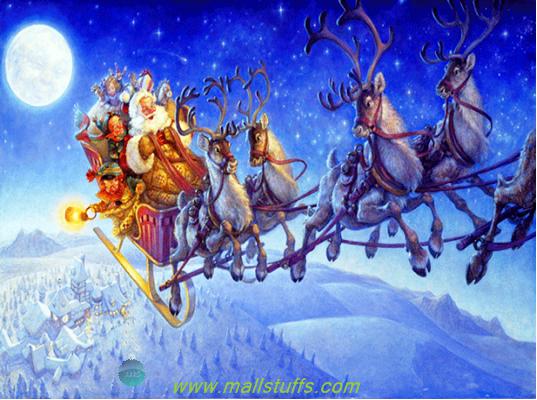
Santa Claus on sleigh vehicle
10) In Ramayana, there is a mention of Lord Brahma, pleased with Kuber severe penance, honoring him all the riches of the world (Nidhis), "equality with gods”. Originally an Asura(demon), Kuber was conferred as the deity of wealth and was gifted a flying chariot known as “pushpak viman”. The description of this flying chariot is strikingly similar to the description of Santa Claus flying sleigh vehicle except that the reindeer is replaced by Swan but note the fact that in case of Santa Claus, reindeer is sometimes shown as polar dogs or beers and hence the animal is not fixed. Even in pushpak viman, some scriptures suggest it to be driven by horses instead of swan.
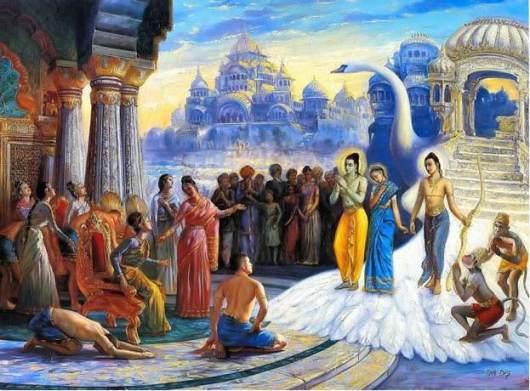
Lord Rama, Goddess Sita, Brother lakshman and hanuman arriving at ayodhya in Pushpak Viman
11) Stories of Santa Claus are relatively a new one in Christianity. It is believed to have originated in the early 17th century somewhere in the northern region of North America or Europe. Santa is typically depicted as a pot-bellied, bearded, jovial benefactor accompanied by polar animals like Rudolph the reindeer. Similarly, Kuber is said to be the lord of mythical animals though there is no description on how the animals look like.
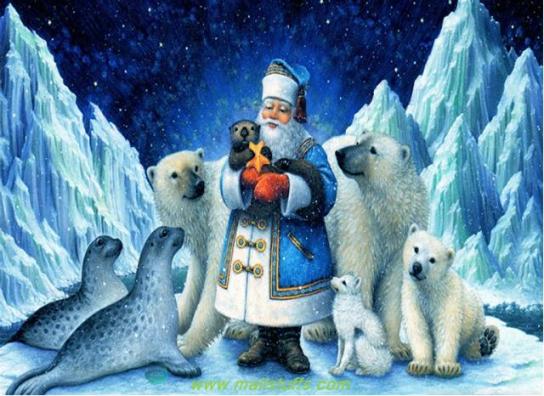
Santa with his Polar companions
Kuber Was lord of Evil spirits
As per the vedic texts, Kuber was originally considered as the chief of all evil spirits like ghosts, demons etc. The Shatapatha Brahmana calls him the Lord of thieves and criminals.
How Kuber became Deity of wealth and lord of northern part of the world
As mentioned before, he was included in the deity pantheon after his severe penance and attainment of several boons from Lord Brahma. Brahma conferred upon Kubera godhood, status as a world-protector, the friendship with Shiva, the Pushpaka Vimana, a son called Nalakubera/Nalakubara, and the lordship of the Nairrata demons. Kuber generously accepted the boons and gift of lord Brahma including Flying chariot Pushpak Viman and settled in the golden beautiful isle of lanka(Presently sri lanka). Note that kubera flying chariot is the same pushpak vimaan which was used by lord ram to travel from lanka to ayodhya after executing Ravana in sri lanka. After his arrival in ayodhya, lord rama returned this pushpak vimaan along with other treasures to deity Kuber.
How Kuber lost his wealth and Pushpak Viman
Demon Ravana, step brother of Kuber was so jealous of his wealth that he attacked Kuber, defeated him and seized all his wealth and treasures including his flying chariot “Pushpak vimaan”. Knowing that he cannot defeat the mighty ravana, he went on to settle in the city of Alaka in Gandhamandana mountain of the Himalayas, very near to Mount Kailash - the abode of lord Shiva. His city is said to be extremely beautiful, glorious with many mythical and magical divine beings. . His city is also known as Alaka-puri ("curl-city"), Vasudhara ("bejeweled"), Prabha("splendour") and Vasu-sthali ("abode of treasures").
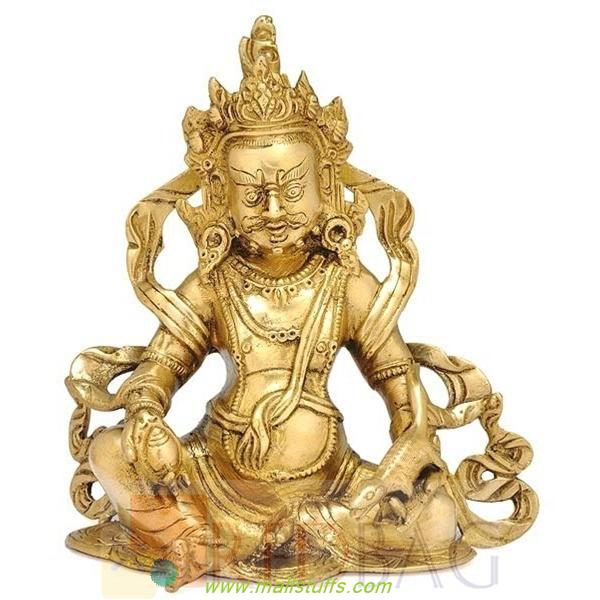
Deity kuber
After his fight with ravana, He is described as having only eight teeth, three legs, and one eye. This deformity is said to have occurred during his fight against the mighty demon ravana.
Kuber in ancient Scriptures
In the Manusmriti, he is called as the respectable Loka-pala, meaning protector of human beings (Semi-divine beings of the northern world), and the patron of merchants. Below image shows the Brahma with his four loka palas (South-north-east and west). Kuber carrying a mace is shown as the lord of the north at second place from right. In Mahabharata, Kubera is described as the brother of sage vishrava, both being son of sage Pulastya and his wife Idavida. Note that the sage pulastya is said to be the divine son of lord Brahma. The Mahabharata says that Brahma conferred upon Kubera godhood, status as a world-protector, the friendship with Shiva, the Pushpaka Vimana, a son called Nalakubera/Nalakubara, and the lordship of the Nairrata demons. Mahabharata also describes the Kuber donation of wealth for the construction of the Pandavas new palace at Indraprastha. According to Padma Purana, lord shiva granted him the kingship of yakshas after Kuber prayed to lord Shiva for many years. In Mahabharata, Kuber kingdom is well glorified. There is the description of magnificent court where Gandharvas(Divine Celestial beings) and Apsaras (Fairies) entertain Kuber. His kingdom of Alaka is said to be attacked by the Pandava prince, Bhima and once by shukra, the preceptor of the demons. Kubera's Nairrata army is described to have defeated king Mucukunda, who then defeated them by the advice of his guru Vashishta.
Deity Kuber made tirupati the world richest temple
According to the puranic story, Kuber credited his treasures and money to the god Venkateshwara (form of god Vishnu) for his marriage with Padmavati. Pleased by his devotion, lord vekateshwara gave him the boon of acquiring more wealth and riches. This is the reason why the devotees go to venkateshwara temple at tirupati to donate millions of rupees in Venkateshwara's Hundi ("Donation pot"); so that the debt of lord vekateshwara on lord kuber is paid back.
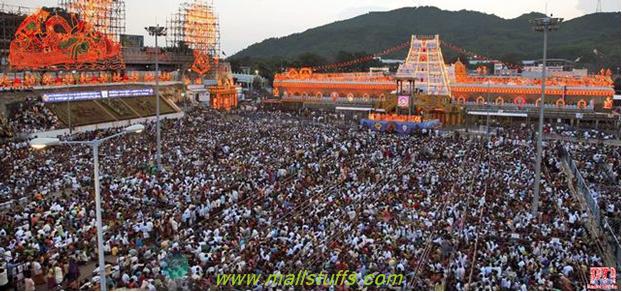
Devotees at venkateshwara temple
Some devotees go to the extent of donating all his wealth to lord vekateshwara. This has made the Tirupati temple, the richest temple of the world and also the richest religious place of the world. Recently, Indian Billionaire Vijay mallya donated 3 kilograms of gold to lord venkateshwara.
Why Kuber is worshipped
Since Kuber was granted the riches of the world, he was prescribed to be worshipped by the ones who desires for wealth. In festival of diwali on the day of dhanteras, devotees are advised to worship kuber along with lakshmi, goddess of fortune for the attainment of wealth and prosperity. Even on television, you will see a bogus advertisement of a device called Dhan lakshmi-Kuber yantra.
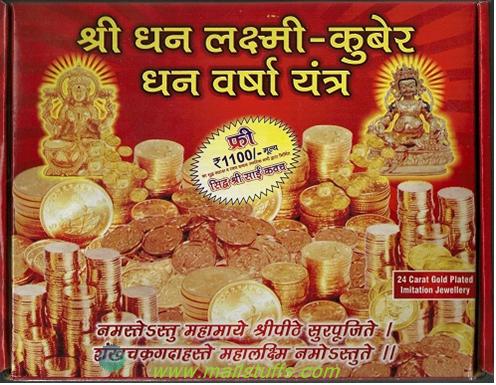
Lakshmi-Kuber yantra advertisement
According to this advertisement, if you bring this device to your home, then you will get all the worldly treasures and prosperity. What a joke? If bringing a device brings prosperity, then there will be no poverty in this world. If device brings prosperity, then what will be the meaning of karma and hard work of the individual?
Kuber in Buddhism and Jainism
Deity Kuber was also adopted by Buddhist and jain monks in their religious scriptures. Scholar Nagendra Kumar Singh remarked, "Every Indian religion has a Kuber after the Hindu prototype". In Buddhism, Kuber is called as Vaisravana or Jambhala. In Japanese Buddhism, he is called as Bishamon or Daiku ku ten and is depicted along with a mongoose. In Tibetan Buddhism, Kuber is called as the laughing Buddha. In Tibet, the mongoose is considered a symbol of Kuber victory over Nâgas-the guardians of precious stones. Buddhist Vaisravana, similar to the Hindu Kuber, is regarded as the lord of the north, a Loka-pala and Lord of Yakshas. Buddhist legends also equate kuber with Pañcika, whose wife Hariti is the symbol of abundance.
In Jainism, Kuber is called Sarvanubhuti or Sarvahna, the attendant Yaksha of the 19th Tirthankar Mallinath. Similar to Kuber, He is depicted with pink complexion, four faces, and eight arms.
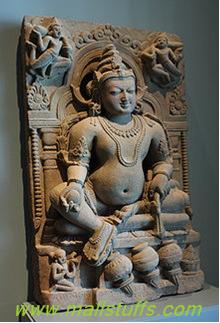
Jambhala, the Buddhist Kuber
Kuber, the king of north
Kubera was honoured with many titles like "king of kings" (Rajaraja), "king of the whole world", "giver of wealth" (Dhanada) and "Lord of wealth" (Dhanadhipati). His titles are sometimes related to his subjects "Lord of Rakshasas" (Rakshasadhipati), : "king of Yakshas " (Yaksharajan), "king of Kinnaras"(Kinnararaja), "Lord of Guhyakas" (Guhyakadhipa), "king of men" (Nararaja), "king of animals resembling men" (Mayuraja). His titles like "Lord of kings" and "best of kings", in contrast to the god of heaven, Indra, led to the belief that Kubera was a man once.
Conclusion
From above, we can see that the description of Santa clause sounds very similar to the depiction of deity Kuber. Whatever the western scriptures says about Santa Claus, all of them can be found in Indian scriptures by the name of deity Kuber. In addition to this, Indian scriptures has all details about his origin, father, mother, how he gained his wealth, how he became king of dwarfs etc. All this details are missing in western description of Santa Claus. So, it is highly possible that the legend of Kuber reached the western shores of the world where the name and the associated character were modified a little to suit their local culture and traditions. Whatever the case is and no matter whom you pray to (kuber/Santa Claus) for gifts/ money/treasures etc, all of your prayers are going to the same Supreme personality of godhead. This once again justifies the point “God is one, only the name got changed across the cultures.”
Wishing you a very Merry Christmas and happy New Year. May Kuber/Santa Claus grant you unlimited riches and prosperity.